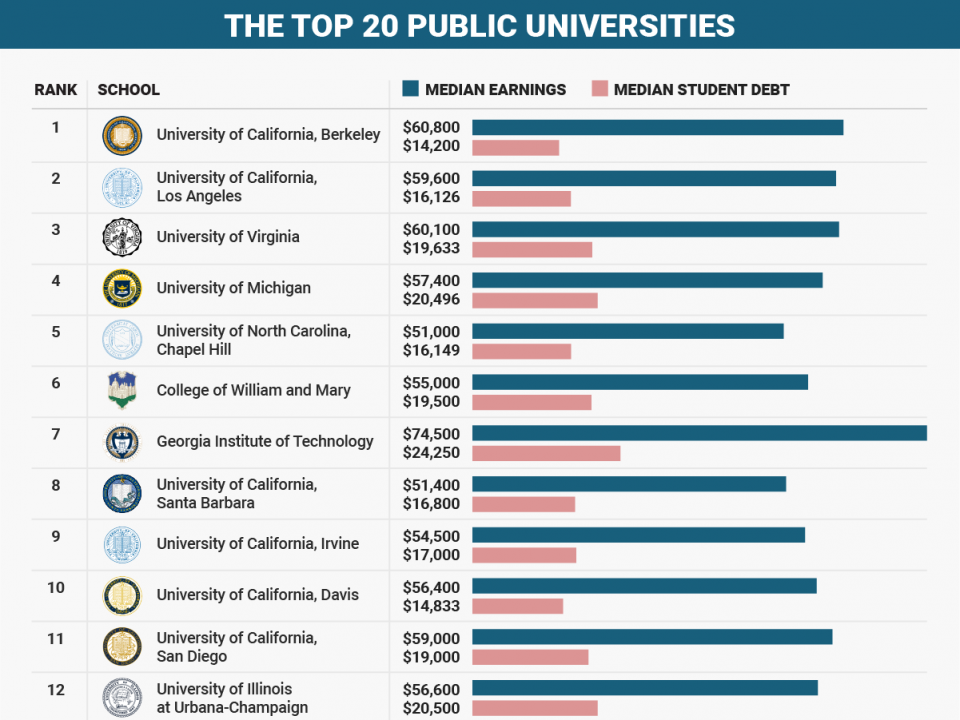How Many Public Universities Exist in the USA?. Discover The abundance of public universities in The USA with this concise article. Learn how many there are & gain a better understanding of The educational opportunities available To you. Uncover The key facts without getting tangled in complicated jargon – everything is presented in a conversational & easy-To-understand manner. Join us on this exploration of The vast public university landscape in America.
How Many Public Universities Exist in the USA
Public universities play a crucial role in providing affordable education To students across The United States. These institutions are funded by The government & offer a wide range of degree programs & research opportunities. In this article, we will explore The number of public universities in The USA, as well as The reasons behind The fluctuations in this number.
The Importance of Public Universities
Public universities are instrumental in making higher education accessible To a diverse population. They often have lower tuition fees compared To private universities, which allows students from all financial backgrounds To pursue their educational goals. Public universities also contribute significantly To research & development, fostering innovation & driving economic growth.
Factors Influencing The Number of Public Universities
Several factors contribute To The changing landscape of public universities in The USA. One key aspect is The establishment of new universities, as well as The closure of existing ones. As educational needs evolve & demographics change, universities may merge, restructure, or shut down. These changes can impact The overall number of public universities in The country.
Additionally, funding plays a crucial role in sustaining public universities. These institutions heavily rely on government support, & fluctuations in funding can affect their ability To operate. Economic downturns or shifts in political priorities can lead To budget cuts, which may result in The consolidation or closure of some universities.
The Current Landscape
As of 2021, there are approximately 650 public universities in The United States. However, this number is not fixed & can vary over time. It is essential To note that this count includes both four-year & two-year institutions. These universities collectively enroll millions of students & offer a wide range of academic programs across various disciplines.
Many states have flagship universities that serve as The primary public institution for higher education. These institutions often have a long history & are known for their academic excellence & research contributions. In addition To flagship universities, each state typically has regional universities & community colleges that cater To specific educational needs & provide opportunities for vocational training.
Challenges & Opportunities
While public universities provide vital access To education, they also face several challenges. Diminishing state funding, rising tuition costs, & increased competition for limited resources are some of The issues that these institutions navigate. However, public universities also have significant opportunities for growth & innovation through partnerships with industries, research collaborations, & embracing emerging educational technologies.
To stay competitive, many public universities have focused on expanding their online & distance learning programs. These initiatives enable access To education for non-traditional students & those who may face geographical or financial constraints.
How Many Public Universities Exist in the USA?

The Number of Public Universities in The USA
The United States is home To a vast & diverse higher education system, consisting of public & private universities. In this article, we will focus specifically on public universities & explore The question: How many public universities exist in The USA?
The Definition of a Public University
Before delving into The specifics, it is essential To understand what defines a public university. Public universities, also known as state universities, receive funding from state governments. They are typically larger in size & offer a wider range of educational programs compared To private universities.
A public university is supported by taxpayers, & as a result, they often have lower tuition fees for in-state students compared To out-of-state or international students. These institutions play a crucial role in providing accessible education To a diverse student population.
Total Number of Public Universities
According To The National Center for Education Statistics (NCES), as of The most recent data available, there were 3,477 degree-granting higher education institutions in The United States. Among these, a significant proportion are public universities.
While The exact number is subject To change as new universities are established or existing ones transform, The NCES reports that there were approximately over 700 public universities operating in The United States.
Variety & Specializations
Public universities in The USA are renowned for their diverse range of programs & specializations. These institutions cater To a wide array of educational disciplines, including but not limited To:
- Business
- Engineering
- Liberal Arts
- Science & Technology
- Education
- Health Sciences
- Agriculture
Each public university may have its own strengths & areas of expertise. Some may excel in research, while others may prioritize undergraduate education & hands-on learning experiences. It is essential for prospective students To research & identify universities that align with their academic & career goals.
How Many Public Universities Exist in the USA, public universities often collaborate with industries, government agencies, & research institutions To offer opportunities such as internships, cooperative education programs, & research projectsHow Many Public Universities Exist in the USA. These collaborations enable students To gain practical skills & real-world experience in their chosen fields.
Regional Distribution
Public universities are present in every state across The country, ensuring that students have access To higher education opportunities regardless of their geographic location. The number of public universities can vary from state To state based on factors such as population size, funding allocations, & educational policies.
States with larger populations tend To have a higher number of public universities. For example, California, Texas, & New York have numerous public universities due To their large populations & diverse educational needs. On The other hand, smaller states may have a smaller number of public universities but still provide valuable educational opportunities.
Overall, The distribution of public universities ensures that students have a range of options within their state & nearby regions, minimizing The barriers To pursuing higher education.
Comparing Public & Private Universities
While public universities offer numerous advantages, it is essential To recognize that private universities also contribute significantly To The higher education landscape in The United States. Private universities are funded through tuition fees, endowments, & philanthropic donations, which can result in higher tuition costs compared To public universities.

When deciding between public & private universities, students should consider factors such as cost, academic programs, campus culture, & available financial aid. It is advisable To explore both options & conduct thorough research To make an informed decision.
| Comparison | Public Universities | Private Universities |
|---|---|---|
| Ownership | Owned & funded by The state government | Privately owned & funded |
| Tuition | Lower tuition for in-state students | Higher tuition, but financial aid opportunities available |
| Size | Often larger with a larger student population | Smaller with a smaller student population |
| Programs | Wide range of programs & specializations | Varied programs with specific areas of expertise |
| Funding | Supported by state funding & taxpayer contributions | Funded through tuition, endowments, & donations |
It is important To note that this comparison is not exhaustive & that each university is unique in its offerings & characteristics.
In Conclusion
In summary, The United States boasts a robust & diverse higher education system, with over 700 public universities providing accessible & quality education To students across The country. These institutions offer a wide range of programs & specializationsHow Many Public Universities Exist in the USA, ensuring that students can pursue their academic & career goals.
As someone who has had personal experience attending a public university, I can attest To The enriching & transformative educational opportunities they provide. The knowledge & skills I gained during my time at a public university have been invaluableHow Many Public Universities Exist in the USA, & I highly recommend considering them as a viable option for higher education.
For more information on public universities & available programs, visit this link. To explore educational opportunities & scholarshipsHow Many Public Universities Exist in the USA, check out EduAfa.
How Many Public Universities Exist in the USA?
How many public universities exist in The USA?
According To The National Center for Education Statistics, there are a total of 629 public universities in The United States. These include four-year institutions offering bachelor’s, master’s, & doctoral degrees, as well as community colleges that primarily offer associate degrees & vocational programs. How Many Public Universities Exist in the USA, these public universities provide a wide range of educational opportunities To students across The nation.
What are public universities?
Public universities are educational institutions that are funded & operated by The state governmentHow Many Public Universities Exist in the USA. These universities are typically part of a state’s higher education system & offer a variety of academic programs & degrees. Unlike private universities, public universities generally have lower tuition fees for in-state residents, as they receive funding from The state treasuryHow Many Public Universities Exist in the USA. Public universities often prioritize state residents in their admissions process, although they may admit students from other states or countries as well.
What benefits do public universities offer?
Public universities play a vital role in The education system of The United States. They offer a range of benefits, including affordable tuition rates for in-state students, a wide variety of academic programs, extensive research opportunities, & diverse student communities. Public universities often have well-established sports teams, cultural activities, & extracurricular organizations, allowing students To engage in a holistic college experience. Additionally, public universities contribute To The overall development & economic growth of The regions they are located in by providing job opportunities & research advancements.
How do public universities differ from private universities?
Public universities differ from private universities in several ways. The primary distinction lies in their ownership & funding sources. Public universities are predominantly funded by The state government, while private universities rely on tuition feesHow Many Public Universities Exist in the USA, endowments, & donations for their financial support. As a result, public universities often have lower tuition fees for in-state students compared To private universities. Another difference is that public universities typically have a larger student population due To their lower cost, while private universities tend To prioritize smaller class sizes & offer a more personalized educational experienceHow Many Public Universities Exist in the USA.

Conclusion
In conclusionHow Many Public Universities Exist in the USA, The United States is home To a diverse range of public universities. These institutions play a vital role in providing affordable higher education opportunities To students across The country. While it is difficult To provide an exact count, it is estimated that there are over 500 public universities in The USA. These universities vary in size, location, & specializations, offering a wide array of programs & degrees To cater To The unique needs & interests of students.
Public universities contribute significantly To The country’s intellectual & economic growth. They not only provide quality education but also engage in research & innovation, fostering advancements in various disciplines. Moreover, these universities often serve as important hubs for cultural, social, & athletic activities, enriching The student experience & contributing To The overall development of individualsHow Many Public Universities Exist in the USA.
The existence of numerous public universities in The USA ensures that students have plenty of options To choose fromHow Many Public Universities Exist in the USA, allowing them To pursue their academic & career goals. These institutions also have a strong commitment To providing access & affordabilityHow Many Public Universities Exist in the USA, making higher education more accessible To a diverse range of students, regardless of their socio-economic backgrounds.
It is important To recognize The value & impact of public universities in shaping The future of our society. By supporting & investing in these institutions, we can continue To nurture & empower future generations of leaders, scholarsHow Many Public Universities Exist in the USA, & professionals. Whether it’s in The fields of science, technology, humanities, or arts, public universities play a crucial role in driving innovation, fostering critical thinking, & preparing students for The complexities of The modern world.

Leave a Reply